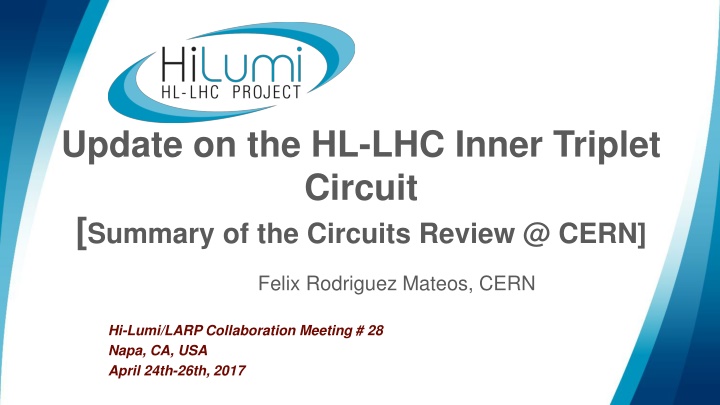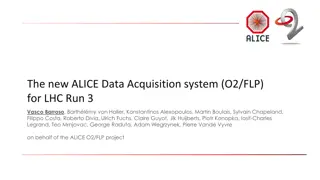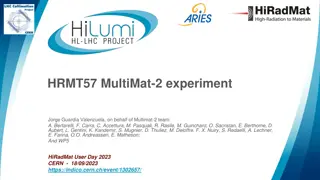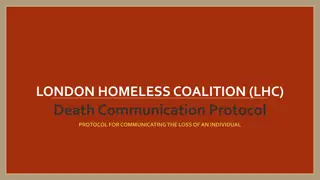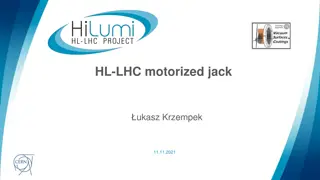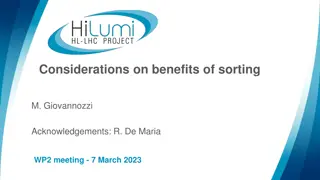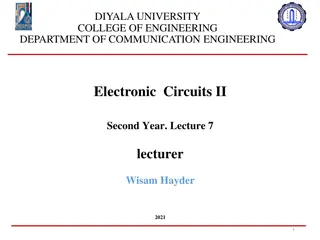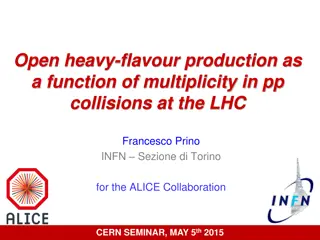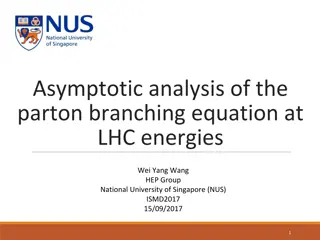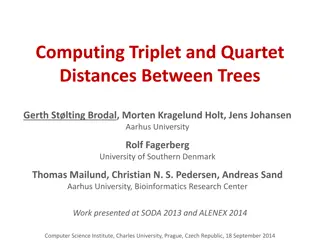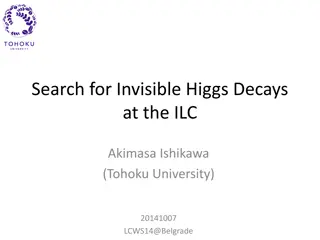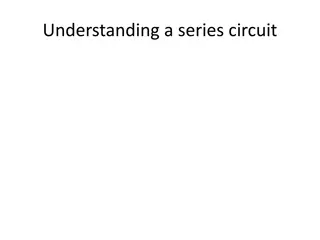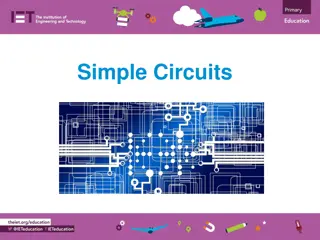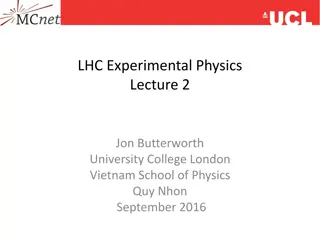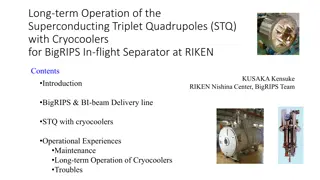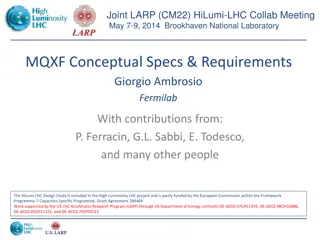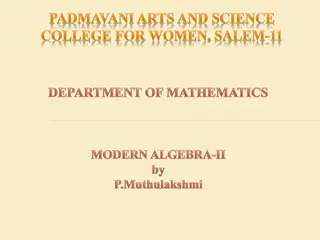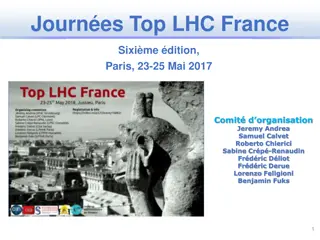Update on the HL-LHC Inner Triplet Circuit
After months of collaborative work, an Internal Review was organized at CERN to address open points at a conceptual level regarding the HL-LHC Inner Triplet Circuit. The review, chaired by Lucio Rossi, focused on recommendations from previous reviews and aimed to resolve outstanding issues. Key sessions covered topics like the 11 Tesla Dipole and the Matching Section, with detailed discussions on circuit layouts, parameters, powering integration, and corrective measures. The meeting provided a platform to evaluate technical developments and make informed decisions for the future development of the circuit.
Download Presentation

Please find below an Image/Link to download the presentation.
The content on the website is provided AS IS for your information and personal use only. It may not be sold, licensed, or shared on other websites without obtaining consent from the author.If you encounter any issues during the download, it is possible that the publisher has removed the file from their server.
You are allowed to download the files provided on this website for personal or commercial use, subject to the condition that they are used lawfully. All files are the property of their respective owners.
The content on the website is provided AS IS for your information and personal use only. It may not be sold, licensed, or shared on other websites without obtaining consent from the author.
E N D
Presentation Transcript
Update on the HL-LHC Inner Triplet Circuit [Summary of the Circuits Review @ CERN] Felix Rodriguez Mateos, CERN Hi-Lumi/LARP Collaboration Meeting # 28 Napa, CA, USA April 24th-26th, 2017
Background After months of common work together with the relevant work packages at the Magnet Circuit Forum (MCF, first meeting July 2016, 15 meetings until now, plus some other topical meetings), some points remained open at a conceptual levelby the end of 2016. It was considered wise to call for a Internal Review at CERN in order to get advice on how to close those open points and take appropriate decisions. The review was organized in a focal way and remained at a conceptual level as technical developments of hardware fall in the domain of the reviewing process that each work package will follow in the course of this year and beginning of next one. 2 Felix Rodriguez Mateos
The HL-LHC Circuits Internal Review took place at CERN on March 17th 2017 Review Panel Lucio Rossi (Chair) Luca Bottura Rudiger Schmidt Andrzej Siemko Thomas Taylor Davide Tommasini Akira Yamamoto Scientific Secretary: Felix Rodriguez Mateos https://indico.cern.ch/event/611018/ 3
PROGRAMME [Times given include time for questions and discussion] 1.Introduction: 8:30 8:35 2.General overview: 8.35 9:20 Welcome L. Rossi Circuit layouts, parameters and schemes Follow up of the recommendations from the 2016 Review Summary of open issues to be resolved at the review F. Rodriguez Mateos Review Programme (1/3) 3.11 Tesla Dipole: 9:20 9:35 M. Giovannozzi Do we need the trim circuit? Discussion on the crowbar resistance and opening of the diodes, rating of trim circuit elements Quench detectors and flux jumps Radiation on the diodes Electrical test levels Documentation 9:35 10:05 S. Yammine COFFEE BREAK 10:05 10:30 4
4.Matching Section: 10:30 10:45 Minimum need of correctors in the MS Optimized use of the existing DSL and local powering integration MCBY correctors connected in series in Q5: powering and protection What is required to preserve the possibility for installation of MQYY + 600A correctors during LS4 or LS5? (cold powering) What is required to preserve the possibility for installation of MQYY + 600A correctors during LS4 or LS5? (warm powering) R. De Maria 10:45 11:15 V. Parma 11:15 11:35 A. Verweij Review Programme (2/3) A. Ballarino 11:35 11:50 J.P. Burnet 11:50 12:05 12:05 13:30 LUNCH BREAK (finger food) INVITED 5
5.Inner triplet: 13:30 13:45 Minimum trim requirements and advantages of the single- circuit configuration Rating of currents (nominal and exceptional operation scenarios) Why parallel elements are required Is it required to use cold diodes? Why? radiation and integration issues Electrical test levels Performance reach of cold powering beyond nominal conditions Performance reach of warm powering beyond nominal conditions J. M. Coello De Portugal F. Rodriguez Mateos 13:45 14:15 Review Programme (3/3) A. Ballarino 14:15 14:45 J.P. Burnet 14:45 15:00 15:00 15:30 6.Closed session of the Panel 15:30 17:00 COFFEE BREAK Closed Session L. Rossi ? 6
30 V Crowbar (1.7 m) Nov 2016 TS1 TS3 TS2 18 kA / 8V D B A C E 2 kA / 10V C+ + 0.12 kA / 10V 2kA / 10V DFHX DFHX DFHX DFHX DFHX + C + + + C C C C Q2b Q1 Q2a Q3 In a conservative scenario where one full magnet quenches by effect of beam, what will the currents be in the parallel paths? In other words, what will be the currents, thermal loads and dI/dt seen by the bus bars, link and current leads? Q2b quenches suddenly and completely (4 poles) 15 ms detection and validation 1 ms CLIQ firing 5ms heater firing Sensitivity analysis w.r.t. parameters Simulation parameters 7 Felix Rodriguez Mateos
Peak currents and dI/dt through s.c. leads and link Simulated worst-case peak currents (Ip), thermal loads (TL) and current changes (dI/dt) in various circuit elements, after an instantaneous quench of the entire Q2b coil at nominal current. Elements O-QH O-QH+CLIQ** Eq. time [ms] Ip [kA] TL [MIIt] dI/dt* [kA/s] Ip [kA]** TL [MIIt]** dI/dt [kA/s] Lead A 16.5 29.8 106 170 16.5 26.4 97 Lead B 5.6 3.9 53 80 4.4 2.3 119 Lead C 4.9 2.5 10 19 3.2 1.0 98 Lead D 5.6 3.9 53 80 4.4 2.3 119 Lead E 16.5 29.8 106 192 16.5 26.4 97 Crowbar TS1 5.6 3.9 53 80 4.4 2.3 119 Crowbar TS2 4.9 2.5 10 19 98 3.2 1.0 Crowbar TS3 5.6 3.9 53 80 119 4.4 2.3 Equivalent times can be deduced from MIITs and Ip in an approximate manner: MIIT/(Ip)2 Nov 2016 *Values in the case O-QH+I-QHthat are very similar to O-QH **Values in the case O-QH+I-QHthat are very similar to O-QH+CLIQ 8 Felix Rodriguez Mateos
Open issues Inner Triplet Current ratings considering nominal and conservative scenarios Performance of cold powering (margins, spares) Parallel elements required? at cold or at warm? cold diodes? Performance of warm powering (margins, 2-quadrant PC, crow- bar) 9 Felix Rodriguez Mateos
Simulations and analysis of the IT protection under different scenarios Emmanuele Ravaioli, LBNL
Simulations: user manual Very conservative cases These simulations consider a quench occurring suddenly in one entire magnet followed by quench detection and validation (15 ms) and quench protection triggering (1 ms, Outer QH+CLIQ) leading to the quench of the other magnets. If not otherwise specified, for all magnets it is assumed RRR=140 and Cu/non-Cu ratio=1.15. Initial conditions : Various simulations assuming the quench of one magnet in Q1, Q2b or Q3. Worst case analysis. Done for nominal and ultimate current. Sensitivity analysis : Influence of the worst distribution of strand parameters (RRR and Cu/noCu ratio). Higher resistivity in the magnet suddenly quenched results in higher peak currents through the leads. Done for nominal and ultimate current. For the case at ultimate current (representing the highest values reached in all simulations), less conservative (more realistic) cases of sudden quench of parts of one magnet: inner layers of all four poles in one magnet; a few turns on the horizontal mid-plane. Quench detection time : Influence of the quench detection+validation time (reference is 5+10=15 ms). Standard quench cases These simulations consider a quench occurring in a spot of a magnet followed by quench detection and validation (15 ms) and quench protection triggering (1 ms, Outer QH+CLIQ). If not otherwise specified, for all magnets it is assumed RRR=140 and Cu/non-Cu ratio=1.15. Initial conditions : Zero current in trims and worst cases. Done for nominal and ultimate current. Sensitivity analysis distribution of strand parameters (RRR and Cu/non- Cu ratio). Higher resistivity in the magnets at higher current results in higher peak currents through the leads. Done for nominal and ultimate current. CLIQ delays : Influence of a delay in the triggering of one CLIQ unit. Also, the case of misfiring of one unit is included. : Influence of the worst 11 Emmanuele Ravaioli
NOMINAL CASES VERY CONSERVATIVE CASES 12 Emmanuele Ravaioli
Conclusions from simulations & analysis in a nutshell for nominal cases, over-currents can go up to 4.3 kA and 2.2 MIITs (approx. nominal and ultimate currents included) => 5 kA current capability in s.c. would suffice for not quenching the conductors within the s.c. link for the very conservative scenario, those values could go up to 6.1 kA (nominal) and 6.8 kA (ultimate), and 5 MIIts (nominal and ultimate approx.) these numbers are obtained considering a full magnet suddenly quenching in its whole volume the analysis covers the whole spectrum of operating conditions, from low to ultimate current 13 Felix Rodriguez Mateos
Panel recommendations on Inner Triplet (1/3) The panel recommends of the removal of the Q2a 120 A trim power converter as magnet sorting can mitigate the use of this trim. Adding a 30 A trim in Q1 in order to compensate the * values It could be possible to use CLIQ leads (10 mm2inside the cryostats). The panel is strongly in favour of the crowbar resistance of 30V proposed (possibly 50V) for the main power converter that reduces the current ramp down time from 1750 s to less than 500 s from ultimate current. 14 Felix Rodriguez Mateos
Inner triplet / changes 18 kA 2 kA 2 kA 0.12 kA 30 A High Impedance DFHX DFHX DFHX DFHX DFHX + + C C + + + + C C C C P1 P4 P2 P3 P3 P2 P4 P1 P1 P4 P2 P3 P3 P2 P4 P1 P1 P4 P2 P3 P3 P2 P4 P1 Q2b Q1 Q2a Q3 Addition of warm diodes & leads remain due to high voltages across the magnet Trim Q2a removal Removable trim PC on Q1a Introduction of a Crowbar Resistance over the main PC 15 Felix Rodriguez Mateos
New Baseline 18 kA 2 kA 2 kA 30 A High Impedance DFHX DFHX DFHX DFHX DFHX + + C C + + + + C C C C P1 P4 P2 P3 P3 P2 P4 P1 P1 P4 P2 P3 P3 P2 P4 P1 P1 P4 P2 P3 P3 P2 P4 P1 Q2b Q1 Q2a Q3 Disadvantages 1. Quench of s.c. link if higher over currents seen (high unlikelihood) 2. Sensitivity to QPS delays (calculations) Advantages 1. Meets operational requirements 16
Option 1 - SC Link Cables 2 kA 5 kA 18 kA 2 kA 2 kA 30 A High Impedance DFHX DFHX DFHX DFHX DFHX + + C C + + + + C C C C P1 P4 P2 P3 P3 P2 P4 P1 P1 P4 P2 P3 P3 P2 P4 P1 P1 P4 P2 P3 P3 P2 P4 P1 Q2b Q1 Q2a Q3 Disadvantages Advantages 1. Reduction of the spares in the s.c. link (no spares other than 2x18 kA) 2. Sensitivity to QPS delays (calculations) 1. Meets requirements of the worst case scenario 2. No quenching s.c. link conductors 3. No changes on the circuit layout 17
Option 2 - D1 Connection in 3-cable configuration 18 kA 2 kA 2 kA 13 kA 30 A High Impedance DFHX DFHX DFHX DFHX DFHX DFHX + + C C + + + + C C C C P1 P4 P2 P3 P3 P2 P4 P1 P1 P4 P2 P3 P3 P2 P4 P1 P1 P4 P2 P3 P3 P2 P4 P1 D1 Q2b Q1 Q2a Q3 Disadvantages Calculations to be redone Design of the bus-bars becomes critical (quench stopper) A new resistance on D1 PC crowbar to be added Disadvantages Advantages Mitigate QPS delays No change in the s.c. link w.r.t. the baseline 5. 1. 2. 3. 4. Adding complexity to the circuit More 18 kA leads No spares for 18 kA cables Warm circuit should be redesigned for 18 kA overcurrent 1. 2. 6. 7. 18
Option 3.1 - Cold Diodes for 5 kA = 100ms 18 kA 2 kA 2 kA 30 A High Impedance DFHX DFHX DFHX DFHX P1 P4 P2 P3 P3 P2 P4 P1 P1 P4 P2 P3 P3 P2 P4 P1 P1 P4 P2 P3 P3 P2 P4 P1 Q1 Q2a Q3 Q2b + + + + C C C C C C + + Advantages Disadvantages 1. Balance voltages 2. Limit currents through the link 3. Less sensitivity QPS delays 4. No change in the s.c. link w.r.t. the baseline 1. Integration 2. Radiation doses 3. Programme for qualification of diodes (time, budget, expertise) 19
Option 3.2 - Cold Diodes + Bus-bars at 18 kA - = 100 s 18 kA 2 kA 2 kA 30 A High Impedance DFHX DFHX DFHX DFHX P1 P4 P2 P3 P3 P2 P4 P1 P1 P4 P2 P3 P3 P2 P4 P1 P1 P4 P2 P3 P3 P2 P4 P1 Q1 Q2a Q3 Q2b + + + + C C C C C C + + Disadvantages Advantages 1. Integration of diodes + heat sinks 2. Radiation doses 3. Programme for qualification of diodes (time, budget, expertise) 4. Integration of 18 kA bus-bars 1. QPS trigger of only quenching magnet 2. Balance voltages 3. Reduction of 1 lead (Q2a Q2b) 4. Limit currents through the link 20 Felix Rodriguez Mateos
Panel recommendations on Inner Triplet (2/3) The panel considers that the presented powering baseline is a robust solution with the upgrade of the 2 kA and 120 A SC trim cables to a minimum of 5 kA and 5 MIITS rating in the superconducting link, and foresees no showstopper in adopting it The panel recommends to continue studies on a possible further optimization for the circuit operation. A possible alternative is the introduction of cold diodes. The panel recommends to develop 18 kA diodes which are qualified for the expected radiation levels. In parallel, an integration study including the position of the diodes and the related bus-bars should be completed Another alternative is to connect the D1 magnet to the IT main circuit using a 3 cables configuration. A study should be done on the application of this topology as a mitigation during machine operation in case of failure 1 of the 18 kA conductors 21 Felix Rodriguez Mateos
Panel recommendations on Inner Triplet (3/3) The panel recommends that work be devoted with utmost priority to the design and the integration of the bus-bars in the inner triplet circuits as well as the cables and feedthroughs for CLIQ. Special attention should be devoted to design and implementation of interconnects and splices. 22 Felix Rodriguez Mateos
Thanks for your attention Acknowledgments: Emmanuele Ravaioli, LBNL Members of the MCF at CERN, in particular Samer Yammine (TE-EPC) and Fernando Menendez (TE-MPE) 23 Felix Rodriguez Mateos
